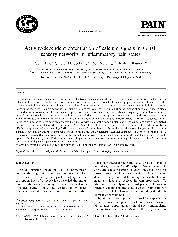摘要
The second messenger calcium is a key mediator of activity-dependent neural plasticity. How persistent nociceptive activity alters Calcium influx and release in the spinal cord is not well-understood. We performed calcium-imaging on individual cell bodies and the whole area within laminae I and II in spinal cord slices from mice in the naive state or 24 h following unilateral hindpaw plantar injection of complete Freund's adjuvant. Calcium signals evoked by dorsal root stimulation at varying strengths displayed a steep rise and slow decay over 15-20 s and increased progressively with both increasing intensity and frequency of stimulation in naive mice. Experiments with pharmacological inhibitors revealed that both ionotropic glutamate receptors and intracellular calcium stores contributed to maximal calcium signals in laminae I and II evoked by stimulating dorsal roots at 100 Hz frequency. Importantly, as compared to naive mice, we observed that in mice with unilateral hindpaw inflammation, calcium signals were potentiated to 159 +/- 10% in the ipsilateral dorsal horn and 179 +/- 8% in the contralateral dorsal horn. In addition to the contribution from NMDA receptors, GluR-A-containing AMPA receptors were found to be critically required for the above changes in spinal calcium signals, as revealed by analysis of genetically modified mouse mutants, whereas intracellular calcium release was not required. Thus, these results suggest that there is an important functional link between calcium signaling in superficial spinal laminae and the development of inflammatory pain. Furthermore, they highlight the importance of GluR-A-containing calcium-permeable AMPA receptors in activity-dependent plasticity in the spinal cord.
- 出版日期2008-11-30
- 单位河北医科大学
